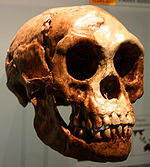Portal:Primates
The Primates Portal A primate is a member of the biological order Primates, the group that contains lemurs, the aye-aye, lorisids, galagos, tarsiers, monkeys, and apes, with the last category including great apes. With the exception of humans, who inhabit every continent on Earth, most primates live in tropical or subtropical regions of the Americas, Africa and Asia. Primates range in size from the 30-gram (1 oz) pygmy mouse lemur to the 200-kilogram (440 lb) mountain gorilla. According to fossil evidence, the primitive ancestors of primates may have existed in the late Cretaceous period around 65 mya (million years ago), and the oldest known primate is the Late Paleocene Plesiadapis, c. 55–58 mya. Molecular clock studies suggest that the primate branch may be even older, originating in the mid-Cretaceous period around 85 mya. Primates exhibit a wide range of characteristics. Some primates do not live primarily in trees, but all species possess adaptations for climbing trees. Locomotion techniques used include leaping from tree to tree, walking on two or four limbs, knuckle-walking, and swinging between branches of trees (known as brachiation). Primates are characterized by their large brains relative to other mammals. These features are most significant in monkeys and apes, and noticeably less so in lorises and lemurs. Many species are sexually dimorphic, which means males and females have different physical traits, including body mass, canine tooth size, and coloration.
Selected article
The evolutionary history of lemurs occurred in isolation from other primates on the island of Madagascar for at least 40 million years. Lemurs are prosimian primates belonging to the suborder Strepsirrhini, which branched off from other primates less than 63 mya (million years ago). They share some traits with the most basal primates, and thus are often confused as being ancestral to modern monkeys, apes, and humans. Instead, they merely resemble ancestral primates. Lemurs are thought to have evolved during the Eocene or earlier, sharing a closest common ancestor with lorisiforms. Fossils from Africa and tests of nuclear DNA suggest that lemurs made their way to Madagascar between 40 and 52 mya. Molecular tests offer an alternative date range of 62 to 65 mya. An ancestral lemur population is thought to have inadvertently rafted to the island on a floating mat of vegetation, although hypotheses for land bridges and island hopping have also been proposed. The timing and number of hypothesized colonizations has traditionally hinged on the phylogenetic affinities of the Aye-aye, the most basal member of the lemur clade.
Having undergone their own independent evolution on Madagascar, lemurs have diversified to fill many niches normally filled by other types of mammals. They include the smallest primates in the world, and once included some of the largest. Since the arrival of humans approximately 2,000 years ago, they are now restricted to 10% of the island, or approximately 60,000 square kilometres (23,000 sq mi), and many are facing extinction. For this reason, researchers have been trying to identify and assess every species. Over the last 10 to 20 years, there has been a steep increase in the number of recognized lemur species and subspecies, both through the discovery of new species and the elevation of existing subspecies to full species status. Currently there are approximately 100 or more recognized species or subspecies of living lemur, which are divided into five families and 15 genera. If the extinct subfossil lemurs are included, an additional three families, eight genera, and 17 species would be included. The recent rise in species numbers is due to both improved genetic analysis and a push in conservation to encourage the protection of isolated and distinct lemur populations. Not everyone in the scientific community supports these taxonomic changes, preferring instead an estimate of 50 living species. Selected picture Emperor tamarins inhabit tropical rain forests, living deep in the forest and also in open tree-covered areas. This diurnal species walks or runs quadrupedally through the forest, spending the majority of its days in the trees with quick, safe movements and broad jumps among the limbs. CategoriesSelected species Extinct (IUCN 3.1)|Extinct Homo floresiensis ( /flɔːrˈɛziːˌɛn.sɪs/ also known as "Flores Man") is an extinct species of small archaic human that inhabited the island of Flores, Indonesia, until the arrival of modern humans about 50,000 years ago. The remains of an individual who would have stood about 1.1 m (3 ft 7 in) in height were discovered in 2003 at Liang Bua cave. Partial skeletons of at least nine individuals have been recovered, including one complete skull, referred to as "LB1". (Full article...) Did you know?
Primate lists
WikiProjectsThings to do
Associated WikimediaDiscover Wikipedia using portals |

















